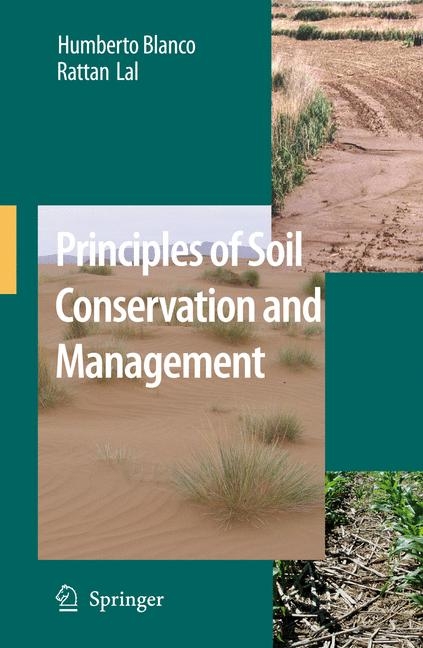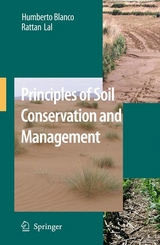Principles of Soil Conservation and Management
- Titel erscheint in neuer Auflage
- Artikel merken
"Principles of Soil Management and Conservation" comprehensively reviews the state-of-knowledge on soil erosion and management. It discusses in detail soil conservation topics in relation to soil productivity, environment quality, and agronomic production. It addresses the implications of soil erosion with emphasis on global hotspots and synthesizes available from developed and developing countries. It also critically reviews information on no-till management, organic farming, crop residue management for industrial uses, conservation buffers (e.g., grass buffers, agroforestry systems), and the problem of hypoxia in the Gulf of Mexico and in other regions. This book uniquely addresses the global issues including carbon sequestration, net emissions of CO2, and erosion as a sink or source of C under different scenarios of soil management. It also deliberates the implications of the projected global warming on soil erosion and vice versa. The concern about global food security in relation to soil erosion and strategies for confronting the remaining problems in soil management and conservation are specifically addressed.
This volume is suitable for both undergraduate and graduate students interested in understanding the principles of soil conservation and management. The book is also useful for practitioners, extension agents, soil conservationists, and policymakers as an important reference material.
Preface; Foreword 1 SOIL AND WATER CONSERVATION; 1.1. Why Conserve Soil?; 1.2. Agents that Degrade Soil; 1.3. Soil Erosion; 1.4. History of Soil Erosion;1.5. Consequences of Soil Erosion; 1.6. Drivers of Soil Erosion; 1.7. Erosion in the USA; 1.8. Global Distribution of Soil Erosion; 1.9. Current Trends in Soil and Water Conservation; Summary; Study Questions; References 2 WATER EROSION; 2.2. Types; 2.3. Processes; 2.4. Factors; 2.5. Agents; 2.6. Rainfall Erosivity; 2.7. Runoff Erosivity; 2.8. Soil Properties Affecting Erodibility; 2.9. Measuring Erosion; Summary; Study Questions; References 3 WIND EROSION; 3.1. Processes; 3.2. Factors; 3.3. Wind Erosivity; 3.4. Soil Erodibility; 3.5. Measuring Wind Erosion; 3.6. Management of Wind Erosion; 3.7. Windbreaks; 3.8. Crop Residues; 3.9. Perennial Grasses; 3.10. Conservation Tillage; Summary; Study Questions; References 4 MODELING WATER AND WIND EROSION; 4.1. Modeling Erosion; 4.2. Empirical Models; 4.3. Universal Soil Loss Equation (USLE); 4.4. Modified USLE (MUSLE); 4.5. Revised USLE (RUSLE): 4.6. Process-Based Models; 4.7. Water Erosion Prediction Project (WEPP); 4.8. Ephemeral Gully Erosion Model (EGEM); 4.9. Other Water Erosion Models; 4.10. Modeling Wind Erosion; 4.11. Wind Erosion Equation (WEQ); 4.12. Revised WEQ (RWEQ); 4.13. Process-Based Models; 4.14. Wind Erosion Prediction System (WEPS); 4.15. Other Wind Erosion Models; 4.16. Limitations of Water and Wind Models; Summary; Study Questions; References 5 TILLAGE EROSION; 5.1. Definition and Magnitude of the Problem; 5.2. Tillage Erosion Research: Past and Present; 5.3. Tillage Erosion versus Water and Wind Erosion; 5.4. Factors Affecting Tillage Erosion; 5.5. Landform Erodibility; 5.6. Soil Erodibility; 5.7. Tillage Erosivity; 5.8. Tillage Erosion and Soil Properties; 5.9. Indicators of Tillage Erosion; 5.10. Measurement of Soil Displacement; 5.11. Tillage Erosion and Crop Production; 5.12. Management of Tillage Erosion; 5.13. Tillage Erosion Modeling; 5.14. Predictive Equations; 5.15. Computer Models; 5.16. Soil Erosion and Crop Harvesting; Summary; Study Questions; References 6 BIOLOGICAL MEASURES OF EROSION CONTROL; 6.1. Functions of Canopy Cover; 6.2. Soil Amendments; 6.3. Cover Crops; 6.4. Crop Residues; 6.5. Residue Harvesting for Biofuel Production; 6.6. Bioenergy Plantations as an Alternative to Crop Residue Removal; 6.7. Manuring; 6.8. Soil Conditioners: Polymers; 6.9. Polyacrylamides; Summary; Study Questions; References 7 CROPPING SYSTEMS; 7.1. Fallow Systems; 7.2. Summer Fallows; 7.3. Monoculture; 7.4. Crop Rotations; 7.5. Cover Crops; 7.6. Cropping Intensity; 7.7. Row Crops; 7.8. Multiple Cropping; 7.9. Double Cropping; 7.10. Relay Cropping; 7.11. Intercropping; 7.12. Contour Farming; 7.13. Strip Cropping; 7. 14. Contour Strip Cropping; 7.15. Land Equivalent Ratio; 7.16. Organic Farming; Summary; Study Questions; References 8 NO-TILL FARMING; 8.1. Seedbed and Soil Tilth; 8.2. Factors Affecting Soil Tilth; 8.3. Tilth Index; 8.4. Tillage; 8.5. Tillage Tools;8.6. Types of Tillage Systems;8.7. Conventional Tillage: Moldboard Plowing; 8.8. Conservation Tillage Systems; 8.9. No-Till Farming; 8.10. Benefits of No-Till Farming; 8.11. Challenges in No-Till Management; 8.12. No-Till and Subsoiling; 8.13. Reduced Tillage; 8.14. Mulch Tillage; 8.15. Strip Tillage; 8.16. Ridge Tillage; Summary; Study Questions; References 9 BUFFER STRIPS; 9.1. Importance; 9.2. Mechanisms of Pollutant Removal; 9.3. Factors Influencing the Performance of Buffer Strips; 9.4. Types and Management; 9.5. Riparian Buffer Strips; 9.6. Filters Strips; 9.7. Grass Barriers; 9.8. Grass Waterways; 9.9. Field Borders; 9.10. Modeling of Sediment Transport through Buffer Strips; Summary; Study Questions; References 10 AGROFORESTRY; 10.1. Importance; 10.2. Classification; 10.3. History; 10.4. Current Trends; 10.5. Functions of Agroforestry; 10.6. Agroforestry and Factors of Soil Erosion; 10.7. Agroforestry and Land Rec
From the reviews:"Blanco and Lal (both, Ohio State Univ.) are experts in soil conservation and management …. The mathematical descriptions for measuring erosion are clearly more appropriate for graduate students in the field …. Summing Up: Recommended. … upper-division undergraduates and above." (M. S. Coyne, Choice, Vol. 46 (8), April, 2009)“Principles of Soil Conservation and Management is a well-designed, practically oriented book addressing many of the contemporary soil resource issues facing land managers in the United States and throughout the world. The book is intended as a resource for undergraduate and graduate students in soil science, agronomy, environmental sciences, agricultural engineering, hydrology, and natural resource management. … a valuable reference manual for soil conservationists, extension agents, and environmental managers. … provides an excellent introductory overview for students entering the field of soil conservation and management.” (Alan J. Franzluebbers, Vadose Zone Journal, Vol. 9 (1), February, 2010)
| Zusatzinfo | biography |
|---|---|
| Verlagsort | Dordrecht |
| Sprache | englisch |
| Maße | 156 x 234 mm |
| Gewicht | 889 g |
| Einbandart | Paperback |
| Themenwelt | Naturwissenschaften ► Biologie ► Botanik |
| Naturwissenschaften ► Biologie ► Ökologie / Naturschutz | |
| Naturwissenschaften ► Geowissenschaften ► Geologie | |
| Technik | |
| ISBN-10 | 90-481-8529-7 / 9048185297 |
| ISBN-13 | 978-90-481-8529-0 / 9789048185290 |
| Zustand | Neuware |
| Informationen gemäß Produktsicherheitsverordnung (GPSR) | |
| Haben Sie eine Frage zum Produkt? |
aus dem Bereich




